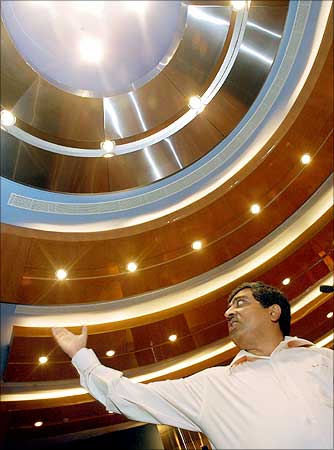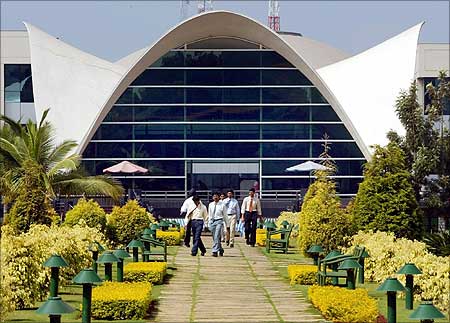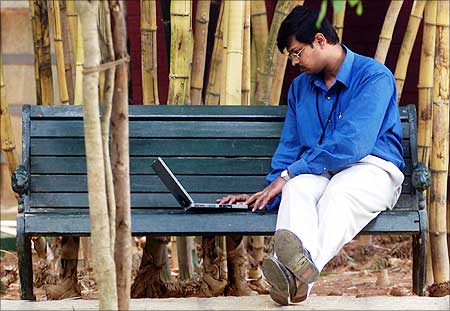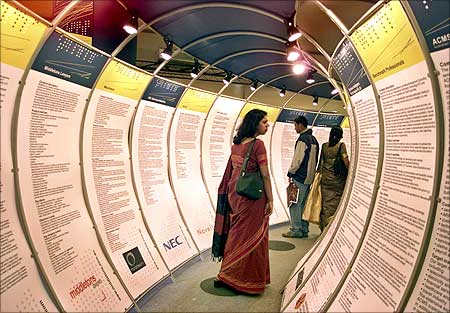Photographs: Rajesh Karkera
N R Narayana Murthy still considers him the best software programmer he has ever come across. But Ashok Arora couldn't -- or just chose not to -- encash the Infosys chief mentor's faith.
Arora was one of the seven Infosys co-founders 28 years ago. That seven is now down to four, the latest being Nilekani, who quit last month to join the government's national identity card programme.
Nilekani was preceded by Arora in 1989 and Nadathur S Raghavan in 2000.
Text: Bibhu Ranjan Mishra, Business Standard
There's life after Infosys
Image: Infosys's Mysore campus.Photographs: Rediff Archives
Nilekani's life after Infosys is pretty much mapped out. But what are Arora and Raghavan doing these days?
Infosys can offer little information on Arora; the software giant does not even have his photograph in its records. The last time anyone from the company's core team met Arora was in early 2000 when he was in Chicago, running an IT consulting practice with his brother who is a chartered accountant.
The consulting firm is still in operation and is believed to be doing reasonably well.
His former employer's lack of information on him is, however, not a surprise. Arora left the company in 1989 at a time when Infosys was on the verge of collapse after KSA-Infosys, an early go-to-market vehicle in the United States with Kurt Salmon Associates, shut shop.
There's life after Infosys
Image: Infosys chief mentor N R Narayana Murthy addresses a Nasscom meet in Mumbai.Photographs: Punit Paranjpe/Reuters
"Those were difficult days," recalls Kris Gopalakrishnan, now Infosys CEO and managing director. "Companies don't see spectacular success overnight always. It requires a lot of patience and perseverance," he adds.
But Arora, a B-Tech from IIT-Bombay (a colleague said he walked into the entrance exam unprepared and came out with flying colours), who wrote most of the critical programs for the company those days, obviously didn't have the patience and sold his shares in the then unlisted company to the other co-founders for just Rs 25 lakh (Rs 2.5 million).
If he had hung on, the soft-spoken Arora would have been a dollar-billionaire today.
"He was a brilliant technology person, but probably found in difficult to cope with the start-up struggles," said one of his former colleagues.
There's life after Infosys
Image: Nandan M Nilekani announces his company's results in Bangalore.Photographs: Jagadeesh Nv/Reuters
The other co-founder, Raghavan retired as joint managing director in 2000 and is doing what he is best at: backing entrepreneurs through Family Office, a venture capital fund, and by setting up a dedicated cell for entrepreneurship at IIM Bangalore.
Industry estimates said Nadathur Holdings, another firm Raghavan owns, has a corpus of around Rs 3,000 crore (Rs 30 billion) invested in some 20 companies. Raghavan has been investing in early-stage technology and biotech companies through various investment arms, and recently diversified into hospitality and real estate.
"They are very choosy about making investments. A core team of four to five people personally oversees investments (shades of the Infosys style of joint management)," said an investment banker close to Nadathur Holdings.
There's life after Infosys
Image: Staff walk around Infosys Technologies campus in Bangalore.Photographs: Pawel Kopczynski/Reuters
Raghavan, 66, now shuttles between Bangalore and Singapore where his sons are settled. A man with about two decades of experience in HR and education research, Raghavan said he was trying to get himself out of the day-to-day affairs of Nadathur Holdings.
"I have taken a back seat and am confining myself to strategic decisions," Raghavan said, not unlike what Narayana Murthy has done in Infosys.
Unlike Arora who didn't stay on to enjoy the fruits of his initial hard labour, Raghavan had a 19-year stint with Infosys.
He had refused to take up the managing director's post in Infosys when it was offered to him, saying such a position when he was ready for retirement might not give bring much value to the company.
There's life after Infosys
Image: An employee of Infosys Technologies Ltd works on a laptop during lunch break in Bangalore.Photographs: Savita Kirloskar/Reuters
"I did not feel that I had the energy to run Infosys at that stage of its scorching pace of growth; I felt a younger person would be better suited. It took them some time to convince themselves that I was serious," Raghavan said.
Indeed, Raghavan had wanted to quit the company in 1998 to pursue a Ph.D, but Murthy was unwilling to let him go. Raghavan finally took voluntary retirement in 2000, seven years after the company's successful IPO.
Raghavan has also founded a non-profit organisation called Foundation for Motivation, Action and Empowerment (FAME India) to help physically and mentally challenged. The NGO runs in a house donated by Raghavan's former colleague and Infosys chief operating officer S D Shibulal.
There's life after Infosys
Image: Indians look at IT posters during the seventh edition of the IT industry exposition.Photographs: Jagadeesh Nv AH/Reuters
Raghavan recalled the earlier days when Infosys was registered as a private limited company on July 2, 1981. The registered office was his house at Matunga in Mumbai.
"We had never thought that Infosys will grow to something so big from a boutique IT infrastructure management company in the eighties," he said.
It appears that Arora was the only one of the original seven who didn't believe in that. Apart from Murthy, Nilekani, Arora and Raghavan, the other three members of the original team who left Patni Computers together to pursue their dreams are S 'Kris' Gopalakrishnan, S D Shibulal and K Dinesh, who is head of head of quality, information systems and the communication design group.









article